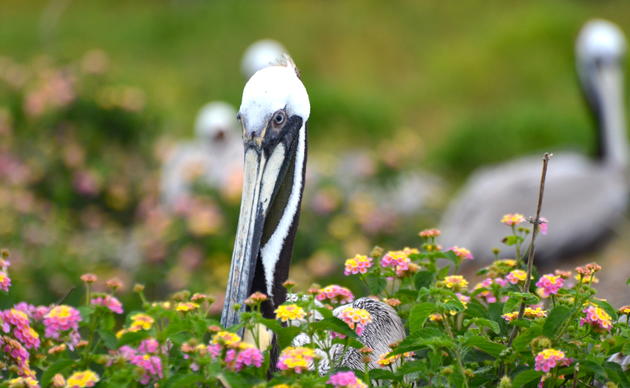Reddish Egret
Reddish Egrets are medium to large herons, found in two color varieties: a dark and a white form. Dark birds have a reddish head and a grey body, while white birds are all white, with a two-toned beak and dark legs. Reddish Egrets are known for their unique foraging habits - they hunt by running and leaping through shallow water in order to scare up prey.
[video:81151|caption:Watch a Reddish Egret in Action!]
Reddish egrets typically nest in mixed-species colonies on coastal islands and forage in shallow, salt-water habitats. In Texas, the species nests on natural and artificial islands in low vegetation, Spanish dagger (Yucca sp.), prickly pear cactus, sea oxeye, sea purslane, goldenrod, ragweed or on bare sand. Nests will be located up to 10 m above the ground Foraging habitat consists of shallow coastal flats, ponds and lagoons including wind tidal flats and alluvial overwash zones of barrier islands. Depth in foraging areas has been noted at 5-15 cm deep. Nesting and foraging habitat have been identified as major limiting factors for the reddish egret by the Gulf Coast Joint Venture Waterbird Working Group. Texas Coastal Sanctuaries host the largest colony of Reddish Egrets in the world, and Texas’ breeding population is estimated to account for 30 – 50 percent of the global population of the species.
For more information on Reddish Egrets, including identification tips, visit their page on the Cornell Lab of Ornithology.
- Lowther, P. E. and R. T. Paul. 2002. Reddish Egret (Egretta rufescens).in A. Poole, editor. The Birds of North America Online. Cornell Lab of Ornithology, Ithaca.
- Vermillion , W. G. and B. C. Wilson. 2009. Gulf Coast Joint Venture Conservation Planning for Reddish Egret. Gulf Coast Joint Venture, Lafayette, LA.
How you can help, right now
Join Audubon Texas Today
Becoming a member supports our local work protecting birds and the places they need.
Consider a Legacy Gift for Texas
Planned gifts and bequests allow you to provide a lasting form of support to Audubon Texas.
Subscribe to Our Newsletter
Subscribe to our newsletter for updates about Audubon Texas's conservation work, and news about our activities and local events.




